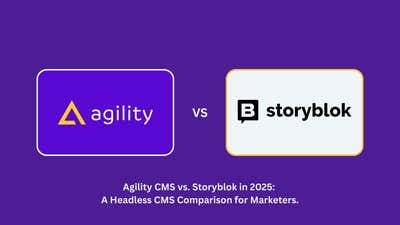How to Deliver a Great Content Experience
How to use Content Experience for attracting customers and keeping them engaged with your brand.


Content experience plays an important role in attracting customers and keeping them engaged with your brand.
Studies show that 51% of customers will quit doing business with a brand after encountering a negative experience. The worst part is that such customers will tell more people about the poor experience than the pleasant experience.
That puts content experience on top of factors like content creation and distribution in lead generation. But what really is content experience?
Unlike content marketing, which involves creating and distributing content, content experience encompasses accessing, consuming, engaging, and responding to content from various channels or platforms to convert a web visitor to a lead.
Content Experience aims to promote conversion, for which it must be visually and emotionally appealing, highly relevant, convenient, personalized, consistent, and timely.
As you can see, content experience is a holistic approach that encompasses a lot. But the most important thing is that marketers should aim to contribute a positive content experience. A positive content experience helps visitors take pleasure in how content is presented, locate what they want, and even make a purchase decision.
If you find it challenging to attract and deliver quality leads or are closing fewer leads even on scaling up your content marketing efforts, probably your content marketing is not the problem, but the experience users get when they come into contact with your content.
Fortunately, there are ways of delivering great content experiences and enjoy its benefits.
1 | Improve UX and UI
Most people think a great content experience starts with the content you create. But of what use is content if the website user experience is poor?
How people interact with your business at every stage of the funnel is important in attracting leads and converting them into customers. That is why it is prudent to make it easier for people to move around your website as they learn about your services.
The first step is to improve your website navigation and usability. Design your homepage or landing page with categories and menus that are easy for users to move around your site.
Ensure also there is correct content flow. Here, what you put above the fold should immediately capture the attention of visitors.
For example, payment options and check-out pages are usually among the first things visitors check when they land on a page. They should be clearly visible, as shown in the example below from CriticalPass so that visitors should not have a problem locating them.
Another tactic is to use a readable font and add white spaces and a color palette that portrays your brand personality. But make sure it doesn’t cloud the visitor’s ability to make a purchase decision.
Add verification badges and HTTPS so that users don’t question whether or not your site is secure. For example, the Huawei YouTube verification badge indicates credibility and that the account is run by an authentic organization.
When customers land on your page, they expect an intuitive design. Unintuitive design is immediately noticeable and is very disruptive as it affects the digital experience of users, which ultimately damages your brand.
2 | Improve your website loading speed
Customers today want faster resolutions and services. They have no patience with slow brands nor websites. If your site is unresponsive, users will lose trust in it and question your ability to meet their demands.
Besides, a slow loading site may make your site look unprofessional, as some fonts and menus won’t load correctly. Web visitors may share the negative experience with others, and they may not return to your site as well. As a result, businesses must constantly monitor and improve their site loading speed.
You can improve your website loading speed by reducing the number of 301 redirects, use tools like Google Page Speed Insight to check your site loading speed, minify JavaScript and HTML codes, reduce the size of your images, make your videos short, and enable browser cache.
A fast-loading website reduces bounce rate, makes the browsing process seamless, and improves the overall experience when interacting with your site.
3 | Optimize content
A great content experience starts when website visitors can easily find information, understand it, and make informed decisions based on what is provided. The first step to optimize your content is using proper formatting and punctuation.
To captivate your readers, ensure your content is readable by adding white spaces and clarifying each point. Remember to add headings, subheadings, and relevant keywords so that readers can search for related information with ease. Besides that, match users’ intent to your content to take the user down the conversion channel.
But optimizing content doesn’t stop there. You need to perform content audits and maintain a consistent flow of fresh content.
When your content is optimized, it reduces friction in your customer journey maps or sales process. You will also understand the needs and expectations of consumers to deliver the right digital experience across all platforms.
Learn more: How To Use Content For Increasing Ecommerce Sales
4 | Leverage multiple content format
Your audience is composed of a diverse group of people. This makes it improper to deliver content only via one format. While text is still the most common content form, it is prudent to mix up your content formats.
Adding relatable visuals and graphics makes reading the text easier and also improves the understanding of the text while content formats like video make your content interactive and engaging. Others, like podcasts, webinars, and infographics, can deliver a positive experience since they can entice customers and move them to the next step in their purchase journey.
There are also popular formats like ebooks, whitepapers, research papers, and virtual reality that you can use to build trust and authority among your users.
For example, retail brands are already incorporating virtual reality and augmented reality into their content to make it more lively.
A good example of a retail brand using augmented reality in its content is IKEA. The company has developed an app, “IKEA Place” that enables customers to virtually “place” their favorite products in their room.
Use several content formats not only to meet the needs of different users but also to attract customers and convince prospects to buy.
While doing that, ensure each content format helps establish you as an authority in your niche. You can achieve this by developing action-oriented content that enables the user to know the next course of action after engaging with the content.
Remember also to encourage users to engage or take action with your content. This can be done by adding CTAs and social sharing buttons. With these, you will easily improve the experience of visitors and improve conversion.
5 | Personalize your offers
There are immense benefits that come from personalizing your content. Personalization improves sales calls and lead nurturing, helps build a passionate audience, and keeps your website fresh. Personalization also increases user experience as it makes the content relatable.
Indeed, when visitors come back to your website and you can remind them of their last login details, payment info, or favorite product, they will find you appealing as you have made things easier for them.
Personalizations help you stand out in this crowded marketplace and attract more customers. 34% of customers are more inclined to promote a brand when content applies to their interest.
Amazon, for example, uses your previous actions to show you viewing recommendations and entice you to the right content.
So what are the ways to improve personalization?
- Use customer feedback to offer a better experience and product offers
- Build relationships that aim to drive value
- Personalized your homepage for every site user and visitor
- Collect behavioral data to offer experiences that attract the interest of your audience
- Leverage interactive marketing and user-generated content
When your content tackles a specific issue and provides a specific solution, you will target your audience rightfully and improve their experience.
Read more: Web Personalization: Its Benefits and Its Use Cases | Agility CMS
6 | Optimize your site for mobile users
Over the last few years, we’ve witnessed tremendous growth in the number of mobile traffic. This is because of the increase in the number of smartphone users and Google giving mobile content first priority.
To deliver a great content experience, businesses must emphasize meeting the demands of mobile users.
Some content to prioritize includes videos and audio since their consumption has increased sharply in the last few years:
[Source]
But how do you optimize your site for mobile users and improve the digital experience of users?
- First, ensure your site is mobile-friendly. You can confirm this using Google mobile-friendly tool.
- Choose a responsive theme.
- Improve loading speed.
- Create a mobile app.
- Enable AMP.
- Redesign your website and offers to suit mobile devices. This would require you to think small screen and refine your design aesthetic.
Bad mobile experiences such as confusing icons, excessively large text or images, and missing CTAs frustrate customers, making them look for your competitors. And when they do this, they share the awkward experience with others in their network. The negative word-of-mouth experience will jeopardize your business altogether.
Read more: A Guide To Optimizing Your Website For Mobile
7 | Use multiple channels
With the expansion of the digital marketplace, your customers are everywhere. Be it through social media, live chat, or website, customers expect to interact with your business on every place or channel.
It is prudent that brands must be in all these places not only to engage with the customer but also to boost customer expectations and experiences.
So try to provide services across every channel. Besides, omnichannel support helps increase your brand visibility.
To deliver a great content experience through different channels, you may need to replace your traditional CMS with a headless CMS. This is especially important for eCommerce brands.
A headless CMS for eCommerce brands can be very useful in facilitating omnichannel support since it propels your content anywhere and everywhere (whether via products, videos, or blog posts) with little hassle.
8| Add trust elements
There has been a growing decline in trust in companies. This is because of the higher expectations consumers have of brands and frustration in accessing services.
However, we have to admit that building trust is difficult. Yet, it is the best way to ensure users come back to your site.
The first step to build trust is to ensure your content is well researched and authoritative. You can achieve this by:
- Linking your site to an authoritative site
- Secure backlinks from a credible site
- Add expert view in your content
- Ensure your site is jam-packed with data and insight
Another way to instill trust is to showcase client brands. The recommended means of achieving this is by displaying trusted third-party logos on your website. It tells website visitors that other large companies trust you and are using your product.
Here’s a simple example from CXL on how you can add trust elements to your product.
User testimonials are also a great way to build trust with visitors. Whether through video recording, ratings, or direct quotes, having people genuinely vouch for you can improve your relationship with every customer.
9 | Create content for your audience
Writing content for your audience requires that you know what your customer wants and needs. So start by defining your target audience or creating your customer avatar.
Unfortunately, creating content for your audience is challenging. Many times you will run out of content ideas or unsure of what to create and share. But there is a solution, and the most direct step is to ask your audience.
You can achieve this by creating a poll or asking your audience on social media regarding the content they would love to see or share. From the answers, come up with the ideal content that will attract and engage them.
Other ways include conducting surveys, social listening, learning from industry peers or competitors, leverage analytics, or monitoring trends. These tactics will help you get information on how leads interact on your website and optimize your content to capture the interest and attention of users.
It will also help you avoid creating one-size-fits content that doesn’t connect with your target audience.
Knowing who you write for can help you narrow your focus to your potential audience or customers, understand your market, create content that users want, make meaningful connections, and increase conversion.
10 | Use Headless CMS with Content Friendly Features
Headless CMSs come in different forms. Some label themselves as API-first, some as content-first, and many other variations of the headless trend. However, there is a problem with the way headless CMSs operate.
Most of them can handle the storage and distribution of content that makes headless so attractive compared to old-style monolithic CMS. These platforms recognize that it’s necessary to push content to various channels outside of standard websites. The ability to connect to APIs and distribute to any front end makes this possible.
The only problem was, those headless CMS solutions focus purely on the usage of APIs to push and pull content to external applications and channels - ignoring the needs of marketers and content authors to create amazing Content Experience.
A pure headless CMS may not be the way forward, but a content-first CMS like Agility CMS can help your marketing, and IT teams to get on track with marketer-friendly features. Agility CMS provides built-in SEO features, content previewing, revision history and the ability to schedule content. These content authoring tools are necessary for marketers to create and edit with ease.
Features like this are perfect for marketing teams, giving them a highly customizable experience and making it easy for them to do things without having to rely on the IT department.
Agility CMS also provides some additional functionality that allows it to stand out compared to others in the headless CMS world and make it easier for content editors to get things done on their own.
Learn More: Why Agility CMS has Page Management as a Headless CMS
Conclusion
As a business, every contact that people make with your content affects how they feel about your brand. So when a visitor comes to your homepage or receives your promotional messages, aim to deliver an experience that engages the audience.
You can do this by ensuring your content is visually appealing, improving UX, optimizing your content, and personalizing it. But the most important factor is to understand who you are writing for. Targeting the right audience is better than using pleasant words. This way, you will deliver a holistic experience to your audience and help your business grow.
--
Adela Belin is a content marketer and blogger at Writers Per Hour. She is passionate about sharing stories with the hope to make a difference in people's lives and contribute to their personal and professional growth. Find her on Twitter and LinkedIn.
Keep Reading
If you want to learn more about Headless CMS, make sure you read these articles:
-
Ecommerce Content Marketing: 6 Content Ideas to Drive Traffic and Generate Sales | Agility CMS
-
How To Choose The Best Headless CMS For Your Brand (2021 Edition)
-
Difference Between Content Marketing and Content Strategy | Agility CMS
-
Tips for Building a Successful Content Marketing Strategy | Agility CMS




